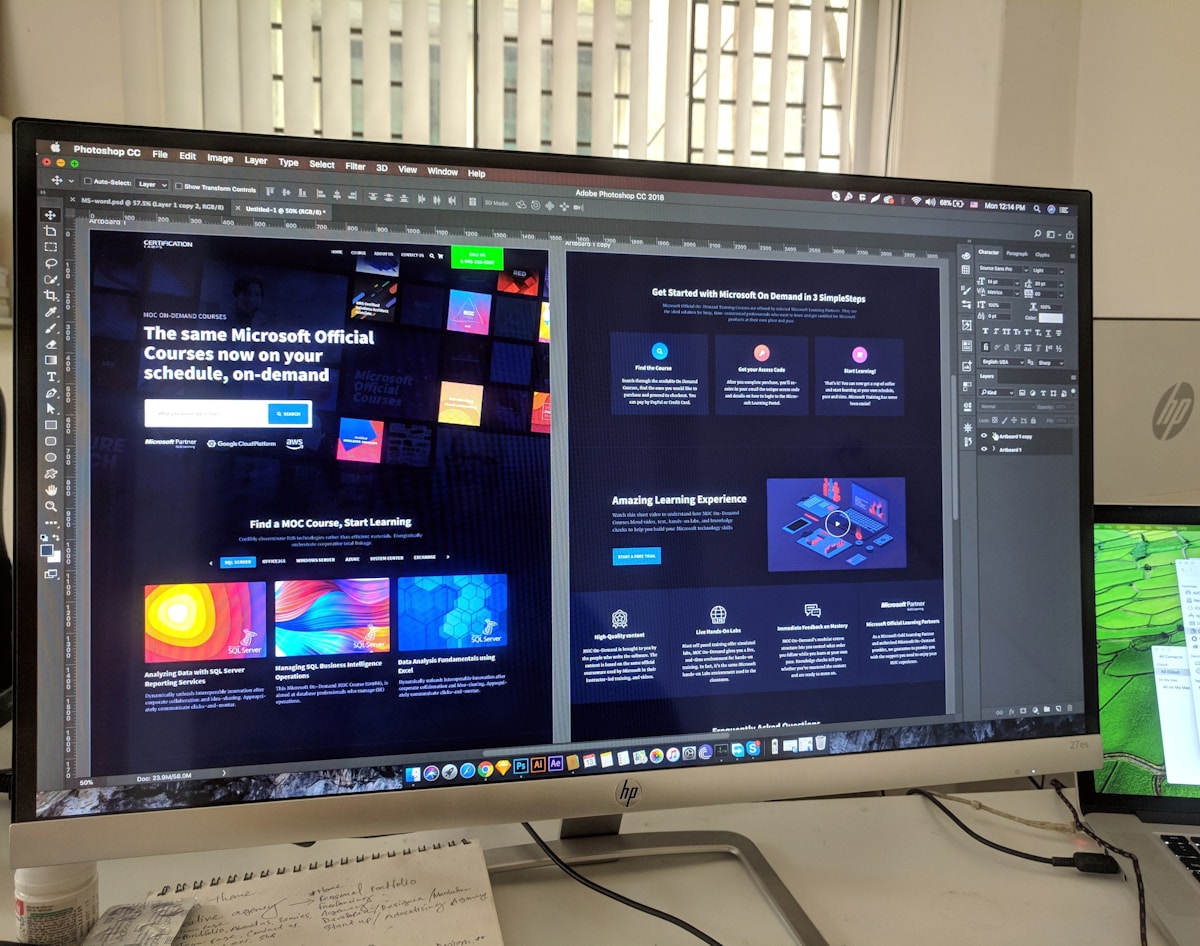Designing Tomorrow: A Comprehensive Guide To Web Design Best Practices For Success
Designing Tomorrow: A Comprehensive Guide To Web Design Best Practices For Success

In today's digital age, having a strong online presence is crucial for businesses to thrive. It is where web design best practices come into play, ensuring your website looks good and functions effectively. A guide to web design best practices can help businesses create a compelling online platform that attracts and retains customers. You can set the stage for success and stand out in the competitive online landscape by understanding the fundamentals of effective web design.
The Importance Of Web Design Best Practices
The best website design is essential when establishing your brand's identity and credibility. It's not just about creating something visually appealing; it's about crafting an experience that resonates with your target audience and drives them to take action. Following web design best practices for business ensures your website is user-friendly, visually appealing, and optimized for performance.
Understanding The Fundamentals Of Effective Web Design
Effective web design goes beyond aesthetics; it encompasses usability, functionality, and overall user experience. You can create a seamless journey for visitors navigating your site by implementing web design best practices. From choosing the right color scheme to incorporating visual content and optimizing for speed, every aspect plays a critical role in shaping the overall success of your website.
Setting The Stage For Success
As you embark on your web design journey, it's important to remember that every decision you make should align with your business goals and objectives. It means considering website design tips, prioritizing user experience, mobile optimization, SEO considerations, and accessibility. You can ensure that your website puts its best foot forward and leaves a lasting impression on visitors by embracing effective web design principles from the outset.
The Basics Of Web Design

Regarding web design best practices, the basics are crucial for creating a visually appealing and user-friendly website. Choosing the right color scheme is essential in setting the tone and mood for your site. Typography and readability play a significant role in ensuring that your content is easily digestible for your audience while creating a user-friendly navigation system is essential for guiding visitors through your website seamlessly.
Choosing The Right Color Scheme
Selecting the ideal color scheme for your website is more than a visual decision; it's a dive into emotion. Beyond personal preferences, understanding color psychology is key. Each hue carries a unique emotional resonance, influencing how visitors perceive your brand.
A harmonious color palette becomes a language that speaks to your brand identity, conveying a mood that resonates with your audience. Whether it's the calming effect of blues or the vibrancy of reds, your chosen colors set the tone for the entire online experience. The thoughtful approach transforms color selection from a mere aesthetic choice into a strategic tool for building a connection, making your business more memorable and relatable.
Typography And Readability
Typography is the silent storyteller on your website, and ensuring its clarity across various devices is paramount. It's not just about choosing visually appealing fonts; it's about making your message accessible and enjoyable to read. Dive into font size, line spacing, and contrast nuances to guarantee readability on screens of all sizes. Prioritize the seamless flow of words, allowing your content to captivate without visual barriers.
You enhance the user experience and communicate your narrative precisely by mastering the art of typography, making your website an inviting space for visitors to engage, explore, and connect.
Creating A User-Friendly Navigation
Imagine your website as a bustling city and the navigation system as the intricate map guiding visitors through its diverse neighborhoods. Crafting a user-friendly navigation experience is about creating a seamless journey for your audience. Clear labels, intuitive menus, and logical hierarchies serve as street signs, ensuring users can navigate effortlessly. The goal is to eliminate the digital maze, providing a straightforward path for visitors to find what they need quickly.
Streamlining the navigation process is not just about convenience; it's a strategic move to enhance user satisfaction. A well-designed navigation system encourages longer browsing sessions, allowing visitors to immerse themselves in the rich tapestry of your digital domain and discover the full spectrum of what your website has to offer.
Responsive Design And Mobile Optimization

In today's digital landscape, it's crucial to ensure that your website is accessible and functional across various devices. Responsive and mobile optimization are key web design best practices that can significantly impact user experience and overall success.
Adapting To Different Devices
Adapting to different devices means creating a seamless experience for users, whether they're accessing your site from a desktop, tablet, or smartphone. It involves designing layouts that automatically adjust to fit various screen sizes and resolutions, ensuring that content remains easily readable and navigable.
Enhancing User Experience On Mobile
With most internet traffic now coming from mobile devices, crafting an exceptional user experience on mobile devices has become non-negotiable. With most internet traffic flowing through smartphones and tablets, prioritizing mobile optimization is a strategic imperative. Let's explore the mobile frontier, exploring nuanced strategies to ensure your website adapts and thrives in your users' hands.
Mobile optimization isn't merely a trend; it's a necessity dictated by user behavior. The ubiquity of smartphones has transformed how people access information, making it imperative for businesses to cater to the preferences and habits of mobile users. The focus here extends beyond mere responsiveness; it delves into the finer details that make the mobile experience accessible and delightful.
Strikingly For Responsive Design
Strikingly offers an intuitive website builder with built-in responsive design features, making creating a mobile-friendly website without extensive coding knowledge easier. With its drag-and-drop interface and pre-designed templates, Strikingly empowers businesses to implement responsive design best practices seamlessly.
Prioritizing responsive design and mobile optimization as part of your web design best practices can ensure that your website delivers an exceptional user experience regardless of the device used.
Optimizing For Speed And Performance
In today's fast-paced digital world, optimizing your website for speed and performance is crucial to ensure a positive user experience. You can enhance the overall performance of your website by minimizing load times, implementing efficient code, and utilizing Content Delivery Networks (CDNs).
Minimizing Load Times
- One key web design best practice is minimizing load times to keep visitors engaged and prevent them from bouncing off your site.
- Compressing images, using browser caching, and reducing HTTP requests effectively reduces load times.
- You can significantly improve the speed at which your website loads by optimizing the size and format of images and files.
Implementing Efficient Code
- Prioritize efficient code for improved website performance.
- Use pointers to streamline code and reduce redundancy.
- Employ CSS sprites to minimize unnecessary elements and optimize page code.
- Leverage pointers for server-side caching to enhance performance.
- Minimize redirects using pointers to implement effective code strategies.
- Focus on efficient coding practices to ensure a responsive and high-performing website.
Utilizing Content Delivery Networks (CDNs)
- CDNs help distribute your website's content across multiple servers in different locations.
- It reduces the physical distance between the user and your website's server, resulting in faster load times.
- Leveraging CDNs can ensure that users worldwide have a consistent and optimized experience when accessing your site.
Incorporating Visual Content

In web design best practices, incorporating high-quality images and videos is essential for creating an engaging user experience. Visual content enhances a website's aesthetic appeal and helps convey information effectively. When choosing images and videos, it's important to ensure they are relevant to the content and optimized for web use to avoid slowing down page load times.
Using High-Quality Images And Videos
In the symphony of web design, the role of high-quality images and videos is nothing short of instrumental. As we navigate the digital landscape, the visual allure of a website becomes a magnetic force, drawing visitors into an immersive experience. Let's delve into the art of selecting and presenting visual content, exploring how high-resolution visuals capture attention and orchestrate a narrative that resonates with your audience.
When curating the visual elements for your website, prioritize high-resolution images and videos that exude clarity and visual appeal. The modern online audience has a discerning eye, and pixelated visuals won't cut it. Invest in crisp, clear visuals, and be capable of precisely rendering every detail. High-resolution imagery enhances the aesthetic appeal of your website and communicates a commitment to quality, establishing a visual identity that reflects positively on your brand.
Balancing Visual Elements With Text
Achieving equilibrium between visual elements and text is pivotal in effective web design for businesses. A surplus of text may overwhelm visitors, while an excess of visuals can dilute your intended message. The strategic use of visuals to complement written content is the key to striking a harmonious balance between text and imagery. It ensures that your website communicates effectively and captivates and guides visitors seamlessly through the narrative. In the dance of design elements, finding the sweet spot between text and visuals is the art that transforms a webpage into a compelling and coherent visual story.
Engaging Users With Interactive Features
Incorporating interactive features like sliders, carousels, or infographics can enhance your website's user engagement. These elements make your website more visually appealing and provide an interactive experience for users, keeping them engaged and interested in exploring your content further.
SEO And Accessibility Considerations
Regarding web design best practices, implementing proper meta tags and descriptions is crucial for improving search engine visibility. Optimizing your website's metadata with relevant keywords and descriptions can enhance its online presence and attract more organic traffic. The guide to web design best practices emphasizes the importance of creating compelling meta tags that accurately reflect the content on each page of your site.
Ensuring ADA compliance is another essential aspect of web design best practices for business. Making your website accessible to disabled users can expand your audience reach and demonstrate a commitment to inclusivity. It incorporates features like alt text for images, keyboard navigation, and screen reader compatibility to ensure visitors can navigate and interact with your site effectively.

Strikingly offers powerful tools for SEO optimization, making it easier for businesses to implement web design best practices that improve their search engine rankings. With built-in features such as customizable meta tags, responsive design templates, and mobile optimization capabilities, Strikingly empowers users to create visually appealing and highly discoverable websites by search engines.
Leveraging these web design best practices for business can help you create a top website design that looks impressive and performs exceptionally well in terms of SEO and accessibility. With the right strategies, you can put your best website forward and maximize its impact on users and search engines. Embracing effective web design principles is key to success in today's digital landscape.
Easily Implement Web Design Best Practices With Strikingly
Choose a Clean, Responsive Template
- Pick a template that suits your style and purpose.
- Ensure it's responsive for various devices.
Optimize Images
- Compress images for faster loading.
- Use high-quality, relevant images.
Maintain Consistent Branding
- Customize colors, fonts, and logos for brand consistency.

Image taken from Strikingly
Clear Navigation
- Organize content logically with a simple, intuitive menu.
Use Whitespace Effectively
- Avoid clutter; use whitespace for readability.
Mobile Optimization
- Test and adjust the mobile version of your site.

Image taken from Strikingly
Compelling Headlines and Content
- Write clear, concise headlines and content.
Include Calls-to-Action (CTAs)
- Place clear, clickable CTAs throughout your site.

Image taken from Strikingly
- Connect and include social sharing buttons.
SEO Optimization
- Customize meta titles and descriptions.
- Use relevant keywords in the content.
Regularly Update Content
- Keep content fresh for user engagement and SEO.
Test and Iterate
- Review analytics to make data-driven improvements.

Image taken from Strikingly
You'll create a user-friendly and visually appealing website by following these steps in Strikingly.
Conclusion
Embracing effective web design principles is crucial for achieving web design success. Businesses can create the best website design that looks great, performs well, and delivers a top-notch user experience by following this guide to web design best practices.
Businesses can achieve web design success by creating visually appealing, user-friendly websites that effectively communicate their brand message and drive conversions. Adhering to these rules ensures that your website attracts more people and makes a lasting impact.
When it comes to website design tips, it's important to always put your best website forward by continuously updating and optimizing your site to meet the evolving needs of your audience. Staying on top of the latest web design trends and technologies can ensure your website remains relevant and competitive in today's digital landscape.
Ultimately, the key to creating the best website design is embracing effective web design best practices and prioritizing user experience, performance, and accessibility. Businesses can create websites that truly stand out by incorporating responsive design, optimizing for speed and performance, incorporating visual content, and considering SEO and accessibility considerations.
